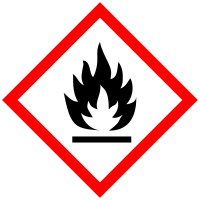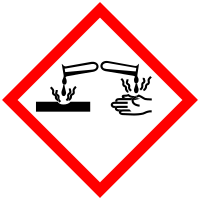
Improving Member States preparedness to face an HNS pollution of the Marine System (HNS-MS)
Dimethylamine Solutions (40%)
Description Top
| CAS number | 124-40-3 |
| UN number | 1032 |
| Chemical formula | C2H7N |
| Standard European Behaviour Classification (SEBC) | Dissolver that evaporates (DE) |
| Abilities | Solution. |
GESAMP Hazard profile
| A1 | A2 | B1 | B2 | C1 | C2 | C3 | D1 | D2 | D3 | E1 | E2 | E3 |
| 0 | R | 3 | 0 | 2 | 0 | 2 | 3B | 3 | Ss | NT | DE | 3 |
Marine pollution Classification (MARPOL Annex II)
| Category | Description |
| Y | Noxious Liquid Substances which, if discharged into the sea from tank cleaning or deballasting operations, are deemed to present a hazard to either marine resources or human health or cause harm to amenities or other legitimate uses of the sea and therefore justify a limitation on the quality and quantity of the discharge into the marine environment. |
Alternate names for this chemical
N-Methylmethanamine
Dimethylamine Solutions (40%)
Solutions De Dimethylamine (40%)
Dimethylamine Solutions (40%)
Solutions De Dimethylamine (40%)
Physico-chemical properties Top
| Chemical formula | C2H7N | |
| Molar mass | 45.084 [g/mol] | |
| State | Liquid at 25°C and 1 atm | |
| Fusion temperature | -38 [°C] | |
| Boiling temperature | 51.5 [°C] | |
| Density |
|
|
| Kinematic viscosity |
|
|
| Hydrosolubility |
|
|
| Vapour pressure |
|
|
| Vapour density | 1.6 |
Behaviour Top
| Log Kow | -0.38 |
| Standard European Behaviour Classification (SEBC) | Dissolver that evaporates (DE) |
Hazards Top



Danger
Hazards statements
Physical
H224
Extremely flammable liquid and vapour.
Health
H302
Harmful if swallowed.
H314
Causes severe skin burns and eye damage.
H332
Harmful if inhaled.
H335
May cause respiratory irritation.
Environmental
H412
Harmful to aquatic life with long lasting effects.
Precautionary statements
Prevention
P210
Keep away from heat/sparks/open flames/hot surfaces. No smoking.
P261
Avoid breathing dust/fume/gas/mist/vapours/spray.
P273
Avoid release to the environment.
P280
Wear protective gloves/protective clothing/eye protection/face protection.
Response
P305 + P351 + P338
IF IN EYES: Rinse cautiously with water for several minutes. Remove contact lenses, if present and easy to do. Continue rinsing.
Storage
P410 + P403
Protect from sunlight. Store in a well-ventilated place.
GESAMP Top
GESAMP Hazard profile
| A1 | A2 | B1 | B2 | C1 | C2 | C3 | D1 | D2 | D3 | E1 | E2 | E3 |
| 0 | R | 3 | 0 | 2 | 0 | 2 | 3B | 3 | Ss | NT | DE | 3 |
A1: Bioaccumulation
| Rating | Description |
| 0 | No potential to bioaccumulate |
A1a:
| Rating | Description | Criteria [mg/l] |
| 0 | No potential to bioaccumulate | Log Kow < 1 |
A1b:
| Rating | Description |
| NI | No Information |
A2: Biodegradation
| Rating | Description |
| R | Readily biodegradable |
B1: Acute aquatic toxicity
| Rating | Description | Criteria [mg/l] |
| 3 | Moderately toxic | 1 < LC/EC/IC50 ≤ 10 |
B2: Chronic aquatic toxicity
| Rating | Description | Criteria [mg/l] |
| 0 | Negligible | NOEC > 1 |
C1: Acute oral toxicity
| Rating | Description | Criteria [mg/Kg] |
| 2 | Moderate | 50 < AOTE ≤ 300 |
C2: Acute dermal toxicity (skin contact)
| Rating | Description | Criteria [mg/Kg] |
| 0 | Negligible | ADTE > 2000 |
C3: Acute inhalation toxicity
| Rating | Description | Criteria [mg/l] (4 hours exposure) |
| 2 | Moderate | 2 < AITE ≤ 10 |
D1: Skin irritation or corrosion
| Rating | Description | Sign | GHS category |
| 3B | Corrosive | Full-thickness skin ne | Corrosive Category 1B |
D2: Eye irritation
| Rating | Description | Sign | GHS category |
| 3 | Severely irritating or corrosive | Severe conjunctoblepha | Irritant Category 1 |
D3: Long-term health effects
| Notation | Hazard endpoint | Description | GHS category |
| Ss | Skin Sensitization | Cause specific skin hypersensitivity or allergy following skin contact | Category 1 for Skin Sensitizers |
E1: Tainting of seafood
| Rating | Description |
| NT | The substance has been tested for tainting and found not to taint following exposure of the fish for 24h to 1mg/l. |
E2: Behaviour of chemicals in the marine environment
| Rating | Description |
| DE | Dissolver that evaporates |
E3: Interference with the use of coastal amenities
| Rating | Interference | Description | Interpretation | Warning |
| 3 | Highly objectionable | 1 is highly acutely toxic; and/or 2 is severely irritant or corrosive to skin or eyes; and/or 3 is carcinogenic, mutagenic or reprotoxic; and/or 4 is a floater or persistent floater with associated health effects | 1 C1 and/or C2 and/or C3 = 4; and/or 2 D1 or D2 = 3, 3A, 3B, or 3C; and/or 3 D3 contains C, M or R; and/or 4 E2 = F or Fp and D3 contains Ss, Sr, T, A, N, or I | Warning issued leading to the closure of amenities |
GHS Security Information



Danger
About the project
HNS-MS is a decision-support tool that Belgian and French maritime authorities as well as coastguard stations can activate in order to forecast the drift, fate and behavior of acute marine pollution by Harmful Noxious Substances (HNS) accidentally released in the marine system.
Contact us
Copyright © 2015–2026 HNS-MS Consortium
 HNS-MS has been funded by DG-ECHO under agreement ECHO/SUB/2014/693705 and runs from 1 January 2015 to 31 March 2017.
HNS-MS has been funded by DG-ECHO under agreement ECHO/SUB/2014/693705 and runs from 1 January 2015 to 31 March 2017.